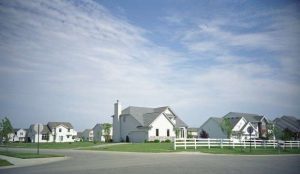MARCH 9, 2019

A new study finds that suburban neighborhoods outperform urban ones across the board.
The rise of the city and the decline of the suburbs has emerged as a common meme in recent years. The young, the educated, and the affluent have come streaming back to the urban core, driving up rents, driving out the poor, and giving rise to patterns of gentrification. The story goes that the suburbs have lost their long-held position as the premier location, being besieged by poverty, economic decline, and other problems once thought to be the province of the inner city.
The trouble is that this picture does not match reality — not by a long shot, according to a detailed new paper published in the journal Urban Studies. Authored by Whitney Airgood-Obrycki of Harvard’s Joint Center for Housing Studies, it looks at the change in the economic status of urban and suburban neighborhoods from 1970 to 2010, a period that overlaps with notions of the resurgence of America’s urban centers and the decline of its suburbs.
Airgood-Obrycki’s study classifies neighborhoods according to three categories—urban core, inner-ring suburbs, and outer-ring suburbs — based on their proximity to the urban center and their density. It further breaks out the suburbs into three additional categories based on when they were developed: prewar, postwar, and modern. Airgood-Obrycki defines the economic status of neighborhoods according to a series of key economic and demographic indicators, including income, college education, employment in professional occupations, home values, rents, vacancy rates, older households (60 years of age and over), and female-headed households.
Her data come from the U.S. Census Longitudinal Tract Database for the period 1970 to 2010, and cover roughly 40,000 census tracts across America’s 100 most populous metro areas.
In contrast to the idea of a Great Inversion — a shift of affluence back to the cities and poverty out to the suburbs — Airgood-Obrycki finds that suburban neighborhoods overwhelmingly outperformed their urban counterparts during the four-decade period spanning 1970 to 2010. Indeed, suburbs increased their economic advantage over urban areas during this time frame.
The share of suburbs making up the top ranks of all urban and suburban neighborhoods (measured as the top quartile) went from roughly two-thirds in 1970 to almost three-quarters by 2010. And the share of suburban neighborhoods in the top two status levels (that is, the upper two quartiles) increased from 56 percent in 1970 to 59 percent by 2010, while the share of urban neighborhoods in these top two levels fell from 41 percent to 36 percent.
The suburban advantage is clear. Across the board, suburban neighborhoods have higher incomes, higher home values, higher shares of college grads, and higher shares of professionals than urban neighborhoods. And suburbs do better than urban areas even when we compare neighborhoods in the same quartile of status.
Among America’s most advantaged neighborhoods (the top quartile), the median incomes of suburban neighborhoods are roughly $10,000 higher than those of their urban counterparts, a gap that has grown from $5,500 in 1970. Conversely, among the nation’s least advantaged neighborhoods (those in the bottom quartile), urban neighborhoods have incomes that are roughly $5,000 lower than in their suburban counterparts—$33,700 versus $38,600. Among declining neighborhoods, urban neighborhoods saw income losses twice as large as those of declining suburbs, $14,040 versus $7,570.
There were considerable shifts in the economic status of America’s neighborhoods over this period. More than half of all neighborhoods (53 percent) saw their status either improve (26 percent) or decline (27 percent). But the most common pattern of all was stability: 47 percent of neighborhoods saw no significant change in their economic status between 1970 and 2010, echoing the findings of Elizabeth Delmelle.
Here again, Airgood-Obrycki finds substantial differences between urban and suburban neighborhoods. Urban neighborhoods were far more likely to remain in lower levels of economic status. More than half of urban neighborhoods that remained in the same status quartile were those at lowest level, compared to less than a fifth of suburban neighborhoods.
High-status urban neighborhoods were actually more likely to see decline than their advantaged suburban counterparts. More than half of urban neighborhoods in the top two quartiles saw their economic status decline, compared to 40 percent of their suburban peers, and the decline in economic status tended to be much steeper for those urban neighborhoods.
But the suburbs are far from monolithic. Indeed, the lion’s share of the gains were confined to newly developed “modern suburbs,” nearly half of which saw gains in economic status between 1970 and 2010. “Modern suburbs saw the greatest gains in nearly every indicator,” the paper notes. By contrast, the oldest suburbs—prewar suburbs, developed before World War II—have consistently been the most troubled and disadvantaged, while immediate postwar suburbs have seen a significant drop in their economic status since 1970.
The reality of America’s urban and suburban neighborhoods is far more complicated than we typically allow. The old dichotomy of declining urban centers and wholly affluent suburbs no longer holds. Many urban centers have gentrified, and poverty and economic dislocation have spread into the suburbs. Despite all of this change, the most affluent places in America largely remain in its more recently developed suburbia.
The once cut-and-dried distinctions between city and suburb have blurred and no longer explain the actual places we live. “While the urban-suburban divide once served as a meaningful dichotomy, suburbs have greater economic inequities among them,” as Airgood-Obrycki puts it. America is becoming a veritable patchwork of economic advantage and disadvantage, spread across its cities and suburbs alike.
Courtesy/Source: CityLab








































































































